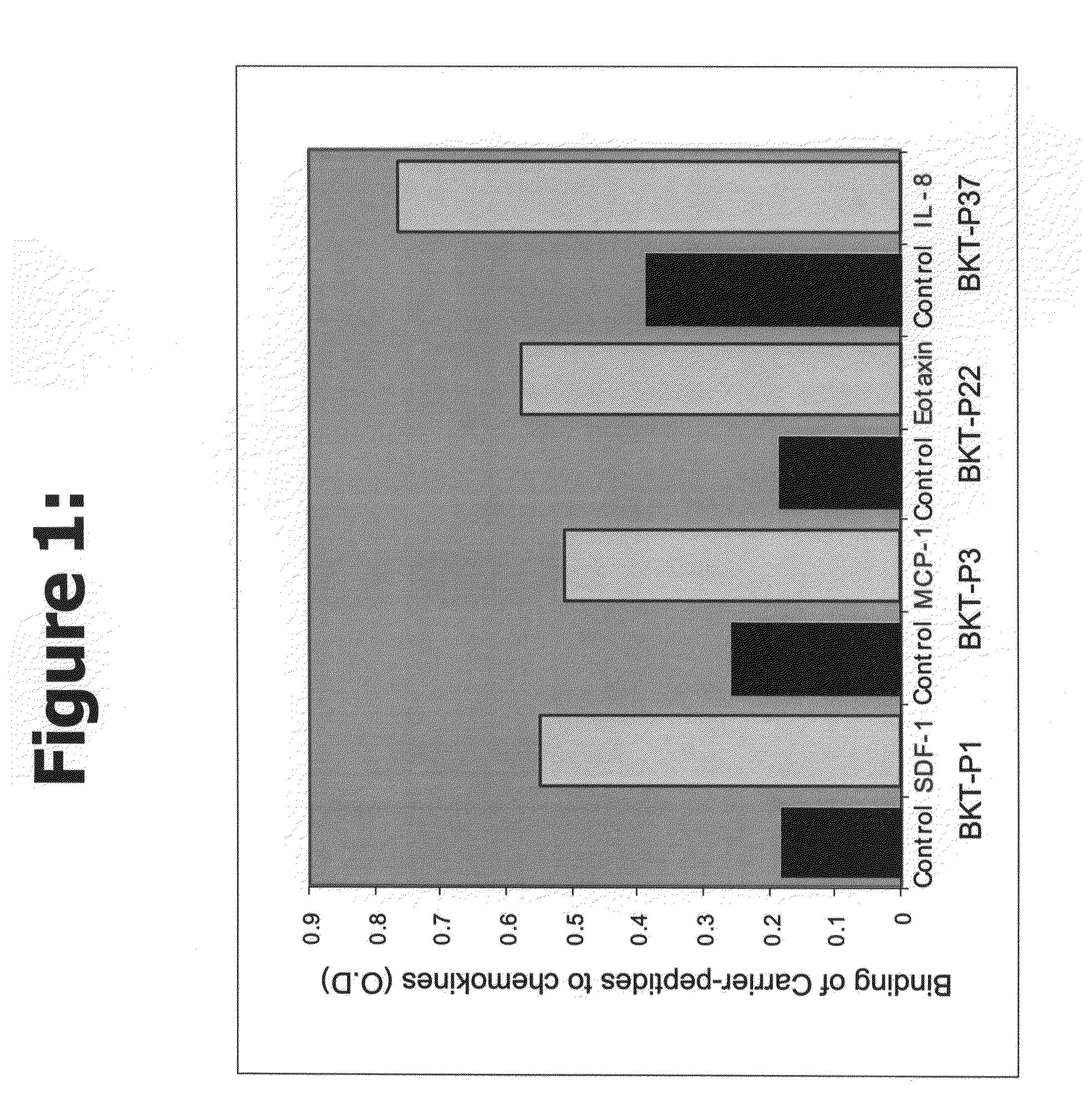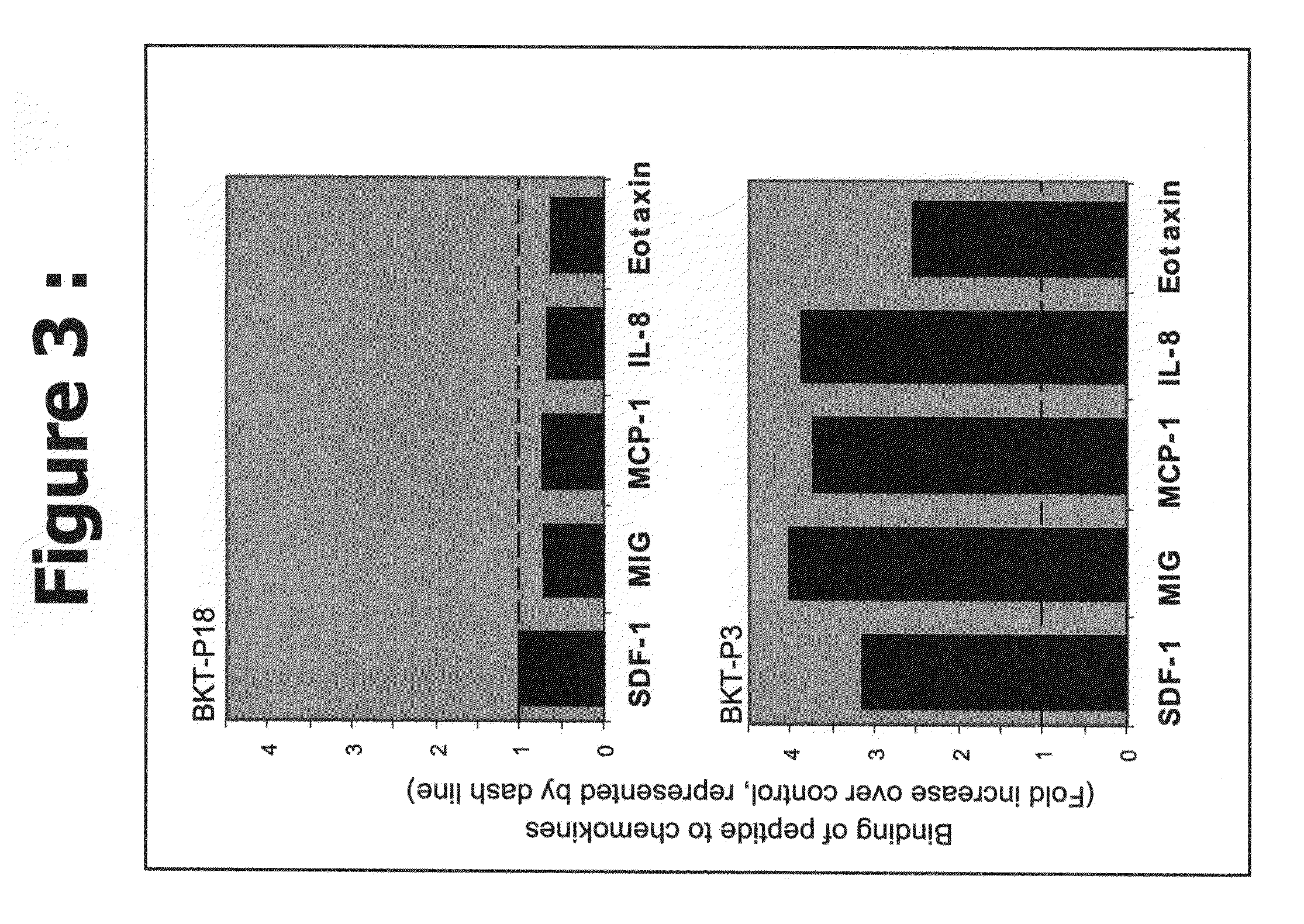Methods of inhibiting chemokine binding to chemokines receptors
a technology of chemokine binding and receptors, applied in the field of new peptidic molecules or peptidomimetic agents, can solve the problems of background art teaching or suggesting sequences or compositions, background art teaching or suggesting nucleic acid molecules encoding for and background art teaching or suggesting methods of treatment employing such peptidic chemokine-binding modulators
- Summary
- Abstract
- Description
- Claims
- Application Information
AI Technical Summary
Benefits of technology
Problems solved by technology
Method used
Image
Examples
example 1
Efficacy of the Peptides of the Present Invention
[0056]This Example demonstrates the efficacy of the peptidic chemokine-binding modulators of the present invention, in a number of different assays, including binding assays and assays for measuring a functional biological effect.
Materials and Methods
Chemokines
[0057]Recombinant chemokines were ordered from PeproTech, Inc. (Rocky Hill, N.J., USA). Human SDF-1α (Cat. No. 300-28A), human MIG (Cat. No. 300-26) and human IL-8, (72 amino acids) (Cat. No. 200-08M), belong to the alpha-chemokines (C—X—C) family. Human MCP-1 (MCAF) (Cat. No. 300-04) and human Eotaxin (Cat No. 300-21) belong to the beta-chemokines (C—C family). All chemokines were prepared according to the company recommendations.
Peptide Synthesis
[0058]Peptides were synthesized in the Weizmann Institute of Science, Rehovot, Israel, in order to perform tests for characterization of their influence on the biological activity of the chemokines. The format of the various synthesize...
example 2
Efficacy of the Peptides of the Present Invention
[0085]This Example demonstrates the efficacy of the peptidic chemokine-binding modulators of the present invention, in a number of different assays, including binding assays and assays for measuring a functional biological effect both in vitro and in vivo.
Materials and Methods
Chemokines
[0086]Recombinant chemokines were ordered from PeproTech, Inc. (Rocky Hill, N.J., USA). Human SDF-1α (Cat. No. 300-28A), human MIG (Cat. No. 300-26) and human IL-8, (72 amino acids) (Cat. No. 200-08M), belong to the alpha-chemokines (C—X—C) family. Human MCP-1 (MCAF) (Cat. No. 300-04) and human Eotaxin (Cat No. 300-21) belong to the beta-chemokines (C—C family). All chemokines were prepared according to the company recommendations.
Peptide Synthesis
[0087]Synthetic peptides were ordered from BioSight Ltd, Karmiel, Israel, in order to perform tests for characterization of their influence on the biological activity of the chemokines. The format of the vario...
example 3
Methods and Compositions for Administration
[0097]The peptides of the present invention, and their homologues, derivatives or related compounds, hereinafter referred to as the “therapeutic agents of the present invention”, can be administered to a subject by various ways, which are well known in the art. Hereinafter, the term “therapeutic agent” includes a peptidic chemokine-binding modulator, as previously defined, including but not limited to, any of the above biologically useful peptides and their homologs, analogs, peptidomimetics and derivatives thereof.
[0098]Hereinafter, the term “subject” refers to the human or lower animal to which the therapeutic agent is administered. For example, administration may be done topically (including ophthalmically, vaginally, rectally, intranasally and by inhalation), orally, or parenterally, for example by intravenous drip or intraperitoneal, subcutaneous, or intramuscular injection.
[0099]Formulations for topical administration may be included ...
PUM
| Property | Measurement | Unit |
|---|---|---|
| concentration | aaaaa | aaaaa |
| pH | aaaaa | aaaaa |
| concentrations | aaaaa | aaaaa |
Abstract
Description
Claims
Application Information
 Login to View More
Login to View More - R&D
- Intellectual Property
- Life Sciences
- Materials
- Tech Scout
- Unparalleled Data Quality
- Higher Quality Content
- 60% Fewer Hallucinations
Browse by: Latest US Patents, China's latest patents, Technical Efficacy Thesaurus, Application Domain, Technology Topic, Popular Technical Reports.
© 2025 PatSnap. All rights reserved.Legal|Privacy policy|Modern Slavery Act Transparency Statement|Sitemap|About US| Contact US: help@patsnap.com



